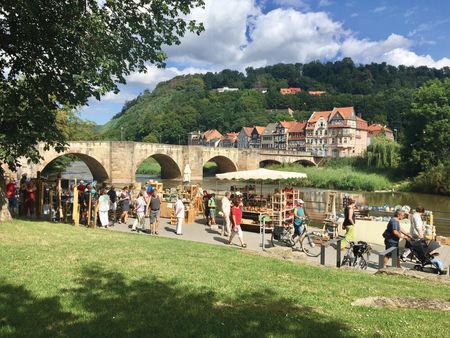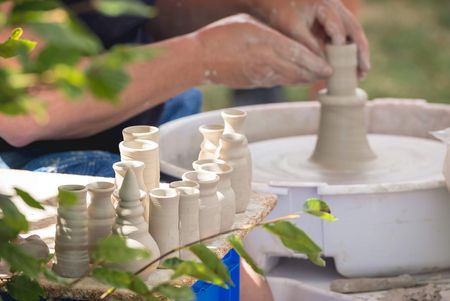Discover craftsmanship at the Dielengraben
 © Hann. Münden Marketing GmbH
© Hann. Münden Marketing GmbH © Rehse
© Rehse
 © Hann. Münden Marketing GmbH
© Hann. Münden Marketing GmbH
Even though I would describe myself as creative in principle, I have had very little contact with pottery. I did attend a pottery course as a child, but my enthusiasm for it was rather short-lived. Moreover, I don't remember any of my artworks surviving into adulthood. So I prefer to leave this form of handicraft to the professionals and then enjoy the finished pieces.
Save the Date
If you feel the same way or if you simply have a soft spot for beautiful things, you should make a note of the 8th and 9th of August for a visit to Hann. Next weekend, the event "Keramik an der Werra" (Ceramics on the Werra) will take place for the third time! Between Dielengraben and Welfenschloss, around 35 potters and ceramists will present themselves directly on the banks of the Werra and invite you to stroll, browse and enjoy the atmosphere. On offer are useful and beautifully shaped items in a surprising variety of shapes and colours. Whether tableware, unique vessels, lamps, garden decorations, sculptures or jewellery - (almost) everything can be made from clay! The range includes pieces fired using the raku method, which creates unpredictable colour effects. There are also ceramics in salt or wood firing, which get their individual colouring and surface texture from firing processes that are thousands of years old.
Lovingly handcrafted
Due to the individual handwork and the effects that are created when the pieces are fired, virtually all products are truly unique. The potters and ceramists - who have all made their passion their main profession - have dedicated themselves heart and soul to the craft. When I talked to an exhibitor at last year's event, his stories made me realise how time-consuming and elaborate the production of ceramic products is. The pottery itself is only half the battle.
The firing process also requires enormous sensitivity and is very time-consuming. Since temperatures of over 1000° are required, the pieces are of course not fired in conventional ovens, but in special pottery kilns. It can take several hours to reach the necessary temperature, and depending on the kiln, it can even take several days until the kiln has cooled down again and the potters can examine the results. Because the temperature distribution in the kiln is not even, care must already be taken when putting the pottery kiln away. After the first firing of clay, the so-called "Schühbrand", you get terracotta - uniquely fired clay without glaze. If the pieces are to be finished with a glaze afterwards, they have to be fired a second time to make the glaze durable.
Hann. Münden ceramics in history
Hann Münden has an interesting connection with ceramics and porcelain: between 1732 and 1854, the Hanstein family's faience factory produced elaborately decorated net vases here. You can admire these in the Hann. Münden Municipal Museum, and some of them are also in the Kestner Museum in Hanover. If you would like to get to know Hann Münden a little better before or after the ceramics market, I recommend a guided tour of the town. These take place daily from May to the beginning of October at 10:30 a.m. and 2:30 p.m.
